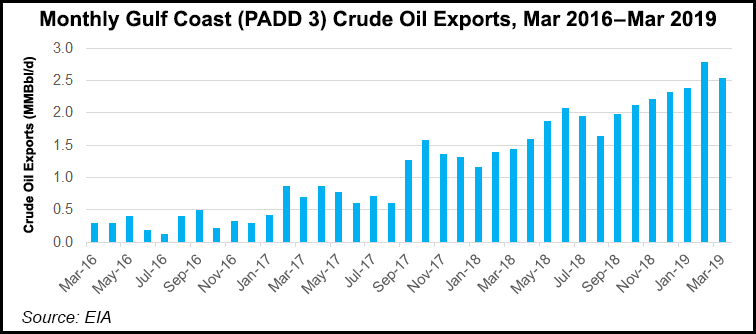In what could be America's next crude export boom, a 1,000-foot ship is expected to pull up to a buoy floating in the Gulf of Mexico next year, hook up its hoses and usher the country's resurgent shale oil to the world market. This historic moment is expected to change the global energy market and cement America's position as a dominant player in the oil export market.

This ambitious plan is being spearheaded by Energy Transfer Partners LP, the Dallas-based pipeline company that has proposed building the first offshore terminal capable of loading supertankers along the U.S. Gulf Coast. The $800 million project, named the Sea Port Oil Terminal, is expected to revolutionize America's crude export market by providing an offshore loading location for the largest oil tankers and offering U.S. shale oil producers a faster, more efficient way to get their products to market. The terminal, which will be located about 28 miles southeast of Port Fourchon in Louisiana, will be able to load an oil tanker at rates of 85,000 barrels an hour, a significant boost to the current pace of loading operations along the Gulf Coast.
The Sea Port Oil Terminal is expected to cost up to $2 billion, but Energy Transfer Partners anticipates it will generate significant revenue for the company and create thousands of jobs. The project has already received support from President Donald Trump, who pledged to ease regulatory burdens on the energy industry and make the United States a dominant energy player in the global market.
The terminal, which is expected to be fully operational by mid-2022, will be capable of loading two supertankers at the same time and will have the capacity to handle up to 2 million barrels of crude oil per day. This will significantly boost America's crude export capabilities, as current loading terminals along the Gulf Coast can only accommodate smaller tankers with a capacity of up to 1 million barrels of oil.
Energy Transfer Partners anticipates that the Sea Port Oil Terminal will revolutionize the global crude market by offering the most efficient and cost-effective way to get crude oil to the world market. The terminal is expected to be a game changer for U.S. shale oil producers, who have struggled to compete with traditional oil producers due to higher transportation costs.
Having our own port, our own terminal and our own export facilities will be an incredibly valuable tool for us to get our crude oil to market, both domestically and internationally, said Kelcy Warren, CEO of Energy Transfer Partners.
The construction of the Sea Port Oil Terminal is expected to bring significant economic benefits to the region. The project is expected to create more than 10,000 jobs during construction and up to 1,000 permanent jobs once the terminal is fully operational. It is also expected to generate significant revenue for the local economy, with estimates suggesting it could generate up to $800 million in tax revenues over the next decade.
In conclusion, the Sea Port Oil Terminal is poised to become America's next crude export boom, as it offers a game-changing approach to loading supertankers and getting crude oil to the world market. The $800 million project, set to be completed by mid-2022, is expected to generate significant revenue for Energy Transfer Partners and create thousands of jobs. It is also expected to boost America's position as a dominant player in the global energy market, cementing the country's position as a key player in the oil export market.

